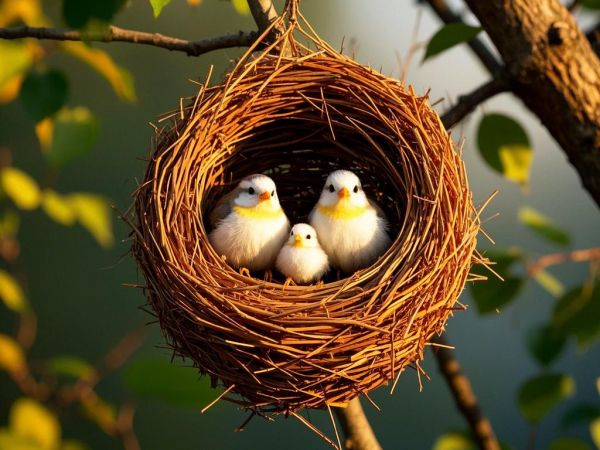Nest Art: Creating Creative Homes for Birds

1. Nest Design: Starting from Bird Behavior
Understanding the nesting habits of birds is the foundation of design. Different species of birds have different needs for their nests. For example, sparrows prefer to nest in hidden corners, while swallows tend to nest under open eaves. Understanding the habits of the target bird species is the first step in designing a suitable nest.
The scientific layout of space. The size, shape, and entrance design of the nest need to be determined based on the body size and living habits of the target bird species. For example, the entrance diameter of nests for small birds is usually around 3-4 centimeters, while larger birds require more space.
The environmental friendliness of material selection. Using natural and harmless materials is the primary principle for making bird nests. Hay, twigs, leaves, and moss are all good choices. Avoid using materials that contain chemicals to ensure the health and safety of the birds.
2. Nest Construction: From Blueprint to Physical Object
Drawing the design blueprint. Based on the body size and living habits of the target bird species, draw detailed design blueprints for the nest. This includes floor plans, elevation views, and cross-sections, marking the dimensions and locations of various functional areas.
Building the main structure. Use treated natural materials to construct the main frame of the nest. Pay attention to sealing at the joints to prevent wind and rain from entering. Lay soft bedding on the ground to protect the eggs and chicks.
Dividing functional areas. Use removable partitions to divide the nest into different functional areas. The resting area should have soft bedding, the activity area should have toys and obstacles, and the excretion area should have a dedicated bird toilet.
3. Nest Decoration: From Practicality to Aesthetic Enhancement
Choosing safe decorative materials. Select non-toxic and harmless decorative materials, such as natural cotton ropes and lead-free paints. Avoid using small particle decorations to prevent birds from accidentally ingesting them.
Adding fun elements. Set up tunnels, platforms, and other facilities in the nest to increase the birds' activity space. Hang some safe toys, such as wooden rattles and grass balls, to enrich the birds' lives.
Reflecting personalized design. Based on the personality traits of the target bird species, design unique decorative elements. You can paint cute patterns on the outer wall of the nest or add personalized nameplates to create a one-of-a-kind nest.
4. Nest Maintenance: Ongoing Care from Construction to Use
The importance of daily cleaning. Develop a detailed cleaning plan to regularly clear out excrement and food residues from the nest. Use specialized pet disinfectants for sanitation to keep the nest clean.
The necessity of regular inspections. Check the structural safety of the nest weekly and promptly repair any damaged parts. Inspect the integrity of decorative items and replace worn toys and facilities.
The continuity of environmental optimization. Adjust the layout of the nest according to seasonal changes. Increase ventilation and cooling facilities in summer, and add insulation materials in winter to ensure the birds are comfortable year-round.
5. Nest Upgrades: Progressing from Basic to Advanced
Intelligent transformation. Consider adding a smart temperature control system to the nest to automatically adjust the internal temperature. Install cameras to observe the birds' activities in real-time.
Ecological design. Plant safe plants that birds can eat around the nest, such as dandelions and plantain. Set up a rainwater collection system for watering the plants.
Enhancing interactivity. Design adjustable partitions to facilitate interaction between the owner and the birds. Add sound-sensing devices to play soothing music, calming the birds' emotions.
6. Nest Culture: Elevating from Practicality to Art
Nest design competitions. Organize creative competitions for nest design, encouraging participants to use their imagination to create nests that are both practical and beautiful.
Nest photography exhibitions. Hold photography exhibitions showcasing nests of different styles and functions, sharing experiences and creativity in bird-keeping.
Nest culture festivals. Establish nest culture festivals to spread knowledge about scientific bird-keeping through lectures, workshops, and other forms, promoting environmental protection concepts.
Making a homemade bird nest is not only a craft project but also a practice in understanding birds and caring for life. By creating a nest by hand, we not only provide birds with a comfortable home but also cultivate responsibility and creativity. This process reminds us that harmonious coexistence with animals requires care and patience, and every life deserves to be treated gently. In the days to come, this love-filled bird nest will witness the happy lives of birds and will also become a beautiful symbol of harmonious coexistence between humans and nature.
As people's attention to bird welfare continues to increase, nest design will also develop in a more scientific and humane direction. Future nests may incorporate more technological elements, such as smart temperature control and automatic cleaning functions, providing birds with a more comfortable living environment. At the same time, nest design will pay more attention to environmental protection and sustainable development, using renewable materials and energy-saving technologies to reduce environmental impact.
The process of making a homemade bird nest is not only an in-depth understanding of the living habits of birds but also a profound reflection on the relationship between humans and nature. In this process, we learn to respect life and care for animals, and we also experience the joy and sense of accomplishment that comes from creation. This small bird nest carries our longing for a better life and embodies our hope for a harmonious nature.
Let us carefully create each bird nest and lovingly care for every life, together creating a better and more harmonious world. In this world, not only can humans live and work in peace, but every small animal can also have its own warm home. This is the ideal we pursue through making homemade bird nests and the effort we make to build a beautiful future of harmonious coexistence between humans and nature.
Through making homemade bird nests, we not only create a practical item but also embark on a journey filled with creativity and warmth. This process teaches us that every detail in life deserves careful attention and that every life deserves gentle treatment. Let us continue to explore, continue to create, weaving more beautiful stories with our hands and nurturing the happiness of every life with our hearts.
相关知识
Nest Art: Creating Creative Homes for Birds
Pet Products For Birds Aviary Iron Fine Wire Large Parrot Breeding Cages Voliere Per Uccelli Bird Nest - Buy Pigeon Loft
breeding Cages
cage Bird Canari
cage For Parrots Hot
bird Breeding Cage Large
cage Larg Parrot
large Parrot Product on Alibaba.com
『转』文鸟繁殖基础
鸟巢 (Nest)
艺术品展示 《女孩与鸟》【Girl with Birds】高清画作
感官污染物改变了陆地鸟类的物候和适应性—小柯机器人—科学网
中西MIDWEST HOMES FOR PETS 高端宠物用品行业领导者
birds productions, birds productions Suppliers and Manufacturers at Alibaba.com
城市化对鸟类筑巢的影响研究综述
南充市同域分布的白腰文鸟白颊噪鹛和白头鹎巢和巢材比较研究
网址: Nest Art: Creating Creative Homes for Birds https://m.mcbbbk.com/newsview1209890.html
| 上一篇: DI微课堂│今天你的挑战是建造一 |
下一篇: 小学生搭建鸟巢 “小精灵”安家落 |

